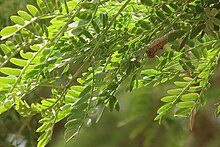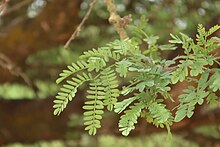Faidherbia
| Faidherbia | |
|---|---|

| |
| F. albidain theElah valley,Israel | |
| Scientific classification | |
| Kingdom: | Plantae |
| Clade: | Tracheophytes |
| Clade: | Angiosperms |
| Clade: | Eudicots |
| Clade: | Rosids |
| Order: | Fabales |
| Family: | Fabaceae |
| Subfamily: | Caesalpinioideae |
| Clade: | Mimosoid clade |
| Genus: | Faidherbia A.Chev. |
| Species: | F. albida
|
| Binomial name | |
| Faidherbia albida | |

| |
range ofF. albida
| |
| Synonyms[1] | |
| |
Faidherbiais a genus ofleguminousplants containing one species,Faidherbia albida,which was formerly widely included in the genusAcaciaasAcacia albida.The species is native toAfricaand theMiddle Eastand has also been introduced toPakistanandIndia.[2]Common names includeapple-ring acacia[3](their circular, indehiscent seed pods resemble apple rings),[4]white acacia,[5]andwinter thorn.[2]TheSouth Africanname isana tree.[2][6]
Taxonomy
[edit]This species has been known asAcacia albidafor a long time, and is often still known as such. Guinet (1969) inPondicherryfirst proposed separating it into the genusFaidherbia,a genus erected during the previous century byAuguste Chevalierwith this as thetype species,seconded by the South African James Henderson Ross (1973) and theSenegaleselegumebotanist Nongonierma (1976, 1978),[7]but authors continued to favour classification underAcaciaas of 1997.[6][7]
Infraspecific variability
[edit]According toJohn Patrick Micklethwait Brenan,as written in theFlora of Tropical East Africa(1959), two forms can be distinguished in this region (Kenya,Tanzania,Uganda). Race A is distinguished by generally smooth features, whereas race B is more hairy. Ross (1979) notes that all trees in the south of central Tanzania belong to race B.[8]Similarly, Nongonierma described two variants for Senegal, var.glabraand var.pseudoglabra,but his distinction was disregarded taxonomically as of 2007.[1]
Description
[edit]Faidherbia is a thornytreegrowing up to 6–30 m (20–98 ft) tall and up to2 m (6+1⁄2ft) in trunk diameter. Its deep-penetratingtap rootmakes it highly resistant to drought. The bark is grey, and fissured when old. There are 11,000 seeds/kg.[citation needed]
Distribution
[edit]InSouthern Africa,it is absent from most of the territory, avoiding dry, colder and upland areas or areas ofwinter rainfall,but it does occur in the easternCaprivi Strip,the northernOkavangobasin, the floodplains of theLinyanti,ZambeziandLimpoporivers, as well as southwards toGaborone.InZimbabwe,the tree is absent from thehighlandsand central plateau, but it does occur inGonarezhou[9]and southwards to theKruger Parkand adjacentlowveldof westernGazaand southernMaputoprovinces. It reaches its southern limit along thePongolafloodplain inMaputaland.[6]In westernNamibia,it is present in theKaokoveld,Damaraland,and theNamib-Naukluftarea.
In the rest of Africa, it is absent from deserts, areas of high rainfall,tropical rainforestsand mountainous areas, but occurs throughout the eastern half of the continent from the southern coast inMaputalandtoEgypt,throughout theSubsaharanSaheland theHorn of Africa.In Northern Africa, besides in Egypt it also occurs inAlgeria,it does not occur inMoroccoproper, but is found inWestern Sahara.[2]
In Asia, it is thought to be native toYemenandSaudi Arabiain theArabian Peninsula,Iran,and in theLevantin Israel,SyriaandLebanon.[2]In Israel, the tree is protected by law.[5]
A population is found inrelictgroves inIsrael(in theShimronnature reserve, near thecommunity settlementofTimrat). All of the trees in a given grove are genetically identical and seem to have multiplied byvegetative reproductiononly, for thousands of years.[citation needed]
Introduced populations are found inCyprus,Pakistan,and India (Karnataka), as well as onAscension Island.[2]
Ecology
[edit]In Southern Africa, it usually grows on alluvial floodplains in bushveld, on riverbanks or flood pans, in swamps, or in dry watercourses that can flood during rains.[6]It grows in woodland in the Sahel, along the Zambezi, and inSudan.[2]In the Sahel, it grows gregariously in groves. It also grows in savannahs in Sudan and the Sahel, in heavy soils with good drainage.[7]
In tropical eastern Africa, it sometimes occurs singly, but may often be the dominant species in dry woodlands.[1]In the Sahel, it has an irregular, clumped distribution, absent in some areas, but occurring in others.[7]
It grows in areas with250–600 mm (10–23+1⁄2in) of rain per year.[8]
Uses
[edit]Faidherbia albidais important in the Sahel for raisingbees,since its flowers provide beeforageat the close of the rainy season, when most other local plants do not.[10]

The seed pods are used for raisinglivestock,are used ascamelfodderinNigeria,[10]and are eaten by stock and game in Southern Africa.[6]They are relished by elephant, antelope, buffalo, baboons and various browsers and grazers, though strangely ignored by warthogs and zebras.[11]
The wood is used for canoes, mortars and pestles, while the bark is pounded in Nigeria and used as a packing material on pack animals. The wood has a density of about 560 kg/m3at a water content of 12%.[12]The energy value of the wood as fuel is 19.741 kJ/kg.[10]
Ashes of the wood are used in making soap and as a depilatory and tanning agent for hides. The wood is used for carving and the thorny branches useful for a natural barbed fence.[13]Pods and foliage are highly regarded as livestock fodder. Some 90% of Senegalese farmers interviewed by Felker (1981) collected, stored, and rationedAcacia albidapods to livestock.[citation needed]Zimbabweans use the pods to sedate fish. Humans eat the boiled seeds in times of food scarcity in Zimbabwe.[citation needed]
It is valued inagroforestryas itfixes nitrogenshortages, and a high yield has been achieved in at least one test plot of maize crops grown amongst the trees at a density of 100 to 25 tree per hectare.[14]According to a 2018 article inThe Guardian,monoculturesof this species are popular in parts ofNiger,where it is known asgaoinHausa,to use forintercropping.

[15]It is also used forerosion control.[citation needed]Its value as an agroforestry tree lies partially in the fact that the tree drops its leaves during the rainy season, and therefore does not compete with crops for sunlight.[16]The trees' use in farmer-managed natural regeneration of degraded soils throughout southern Niger since the 1990s has been described by one writer as "the biggest positive environmental transformation in the Sahel, and possibly in Africa".[17]
Medicinal uses
[edit]An extract is used to treat ocular infections infarmanimals.[10]The bark is used in traditional medicine in Southern Africa,[6]and Niger.[15]
Cultural significance
[edit]
Faidherbia albidais known in theBambara languageasbalanzan,and is the official tree of the city ofSegouon theNiger Riverin centralMali.[18]According to legend, Segou is home to 4,444balanzantrees, plus one mysterious "missing tree" – the location of which cannot be identified.[citation needed]
InSererand some of theCangin languages,it is calledSaas.Saasfigures prominently in thecreation myth of the Serer people.According to the myth, it is thetree of lifeand fertility.[19]
References
[edit]- ^abcAfrican Plants Database:Faidherbia albidaArchived2007-09-26 at theWayback Machine
- ^abcdefgILDIS LegumeWeb
- ^C.Michael Hogan, ed. 2010.Faidherbia albida.Encyclopedia of Life.
- ^Armstrong, W. P."Unforgettable Acacias, A Large Genus Of Trees & Shrubs".Wayne's Word.Archived fromthe originalon 10 November 2015.Retrieved17 November2015.
- ^abShmida, Avi (2005).MAPA's Dictionary of Plants and Flowers in Israel(in Hebrew). Tel-Aviv: MAPA Publishers. p. 260.OCLC716569354.
- ^abcdefvan Wyk, Braam; van Wyk, Piet (1997).Field Guide to trees of southern Africa.Cape Town: Struik. p. 500.ISBN1-86825-922-6.
- ^abcdGeerling, Chris (15 July 1982). "Guide de terrain des ligneux Saheliens et Soudano Guineens".Mededelingen Landbouwhogeschool Wageningen(in French).82(3): 177, 178.
- ^abFAO:Handbook on Seeds of Dry-Zone Acacias
- ^Cunliffe, Rob; Muller, Tom; Mapaura, Anthony (August 2012)."Vegetation survey of Gonarezhou National Park, Zimbabwe (Final report)"(PDF).gonarezhou.org.Frankfurt Zoological Society et al.Retrieved6 April2023.
- ^abcdWorld AgroForestry
- ^Kevin M. Dunham (1990). "Fruit production byAcacia albidatrees in Zambezi riverine woodlands ".Journal of Tropical Ecology.6(4): 445–457.doi:10.1017/S0266467400004843.S2CID85090695.
- ^FAO:Role of acacia species in the rural economy of dry Africa and the Near East
- ^VITA (1977)[full citation needed]
- ^Bayala, Jules; Larwanou, Mahamane; Kalinganire, Antoine; Mowo, Jeremias G.; Weldesemayat, Sileshi G.; Ajayi, Oluyede C.; Akinnifesi, Festus K.; Garrity, Dennis Philip (2010-09-01)."Evergreen Agriculture: a robust approach to sustainable food security in Africa"(PDF).Food Security.2(3): 197–214.doi:10.1007/s12571-010-0070-7.ISSN1876-4525.S2CID12815631.
- ^abMacLean, Ruth (2018-08-16)."The great African regreening: Millions of 'magical' new trees bring renewal".The Guardian.
- ^Becking, David."Faidherbia albida".Trees SA.Retrieved24 December2020.
- ^Villalón, Leonardo, ed. (2021). "Chapter 11: Land Use Change and Climate-Smart Agriculture in the Sahel".The Oxford Handbook of the African Sahel.Oxford University Press. pp. 209–230.ISBN9780198816959.
- ^BBC News story on Mali'sFaidherbia albidatrees
- ^(in French)Gravrand, Henry,"La civilisationsereer",vol. II: Pangool, Nouvelles éditions africaines,Dakar,1990, pp. 125–127,ISBN2-7236-1055-1
Further reading
[edit]- Edmund G.C.Barrow. 1996.The Drylands of Africa:Local Participation in Tree Management.Initiatives Publishers: Nairobi, Kenya.
- A.E.G.Storrs. 1979.Know Your Trees: Some Common Trees Found in Zambia.Government Republic of Zambia, Forestry Department: Ndola, Zambia.
- Africa: Forestry, Agroforestry and Environment
- Hawaiian Ecosystems at Risk project (HEAR)
- Purdue University New Crop Resource Online Program
External links
[edit] Data related toFaidherbia albidaat Wikispecies
Data related toFaidherbia albidaat Wikispecies Media related toFaidherbia albidaat Wikimedia Commons
Media related toFaidherbia albidaat Wikimedia Commons- Faidherbia albidainWest African plants – A Photo Guide.
- "Faidherbia albida".PlantZAfrica.com.Archived fromthe originalon 2008-01-17.Retrieved2010-02-09.
- Faidherbia albida


